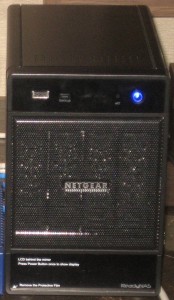I am seeing increasing reference to the “cloud” concept in marketing literature for consumer and small-business network-attached storage devices by their vendors. It is typically talked of in the concept of a “personal cloud” surrounding the NAS device and is used across the product range.
Examples of this include Western Digital’s My Book Live NAS, PogoPlug USB file servers and Iomega’s “Cloud Edition” NAS range.
What it is about
This feature is primarily about an easy-to-establish remote-access system for the NAS device so you can gain access to the files on this device from the Internet. The manufacturers tout this as an alternative to storing data on public-cloud file-storage services like Dropbox, iCloud, Windows SkyDrive or setting up private FTP or HTTP access to the data-storage facility your ISP or Web host may provide.
It is based on the NAS having vendor-supplied software to link with a cloud-based service that makes it easy to locate on the Internet even if you use a regular dynamic-IP Internet service. The vendor may supply desktop and mobile software to facilitate this discovery and / or establish a user-subdomain or directory name that is part of their “remote-access” service domain.
Of course, your data still resides on the NAS with the vendor’s service cloud being the Internet-side discovery link for the device. As well, all of these personal clouds use encryption of a similar standard to what is used to secure your Internet-banking session.
This idea has been existing for over the last few years with vendors providing their simplified remote-access solutions for their NAS products but they are using the current emphasis on cloud-computing technology as a marketing tool for this functionality. This is in a similar vein to how online services have been marketed using the cloud term even though they use this concept.
How can it be taken further
Currently this cloud concept is being exploited further with smartphones and tablets by the NAS vendors providing free data-access apps on their platforms’ app stores. Here the apps allow the users to use the mobile device’s user interface to transfer the desired data between the NAS and the device’s local storage. Some of us would see it as a way to offload picture data from the smartphone to the DLNA-enabled NAS or pull down important data to the smartphone or tablet.
Netgear is even working with Skifta to provide remote access to media content on its ReadyNAS units and allow a PC or Android phone to share the content from the remote ReadyMAS device with DLNA-compliant AV equipment.
The Iomega solution is implementing the Personal Cloud concept as a backup and peer-to-peer replication setup; as well as a remote-access method. But as more manufacturers get on the bandwagon, there may be the issue of providing a vendor-independent “personal cloud” in order to encourage competition and innovation.
What should my network have
The network has to have a router that is set up for UPnP IGD functionality at its network-Internet “edge” for the cloud-based remote access to run properly. This will apply to most retail and ISP-supplied routers, but you may have to make sure this function is properly enabled.
You don’t need to have a fixed IP address or a “DynDNS” program running on your equipment to have this personal cloud operate because the vendor-supplied software on the NAS takes care of the location and access function. But it should have a reliable Internet connection and you may want to put the NAS and network-Internet “edge” equipment on a uninterruptable power supply to assure high availability even with rough power supply conditions. It may be worth reading this article that I wrote about keeping “sanity” on your home network during periods of power unreliability if you want to keep that personal cloud alive.
But avoid the temptation to use a Wi-Fi wireless connection to connect a NAS to your router, even if the NAS does have Wi-Fi connectivity. Instead, connect it to your router with an Ethernet cable, so you have reliable operation.
Conclusion
In the context of the consumer or small-business network-attached storage system, the “cloud” feature is simply being used as a way to describe a simplified remote-access environment for these devices.

